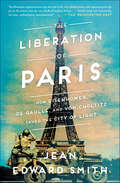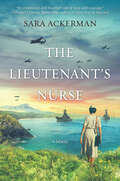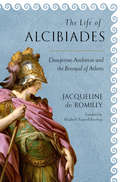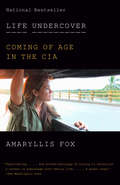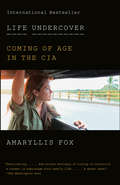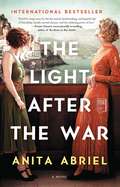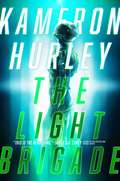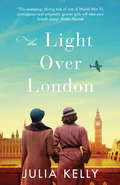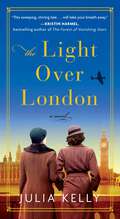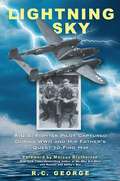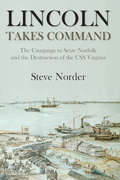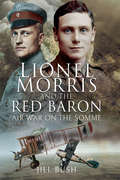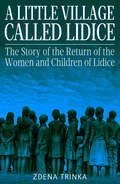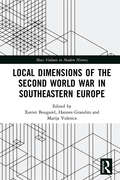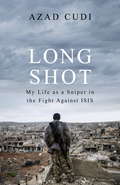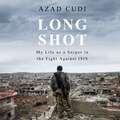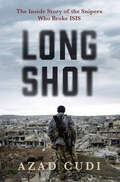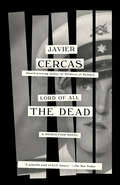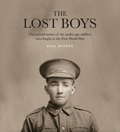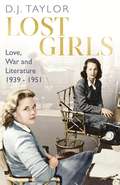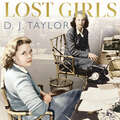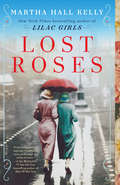- Table View
- List View
The Liberation of Paris: How Eisenhower, de Gaulle, and von Choltitz Saved the City of Light
by Jean Edward SmithPrize-winning and bestselling historian Jean Edward Smith tells the &“rousing&” (Jay Winik, author of 1944) story of the liberation of Paris during World War II—a triumph achieved only through the remarkable efforts of Americans, French, and Germans, racing to save the city from destruction.Following their breakout from Normandy in late June 1944, the Allies swept across northern France in pursuit of the German army. The Allies intended to bypass Paris and cross the Rhine into Germany, ending the war before winter set in. But as they advanced, local forces in Paris began their own liberation, defying the occupying German troops.Charles de Gaulle, the leading figure of the Free French government, urged General Dwight Eisenhower to divert forces to liberate Paris. Eisenhower&’s advisers recommended otherwise, but Ike wanted to help position de Gaulle to lead France after the war. And both men were concerned about partisan conflict in Paris that could leave the communists in control of the city and the national government. Neither man knew that the German commandant, Dietrich von Choltitz, convinced that the war was lost, schemed to surrender the city to the Allies intact, defying Hitler&’s orders to leave it a burning ruin.In The Liberation of Paris, Jean Edward Smith puts &“one of the most moving moments in the history of the Second World War&” (Michael Korda) in context, showing how the decision to free the city came at a heavy price: it slowed the Allied momentum and allowed the Germans to regroup. After the war German generals argued that Eisenhower&’s decision to enter Paris prolonged the war for another six months. Was Paris worth this price? Smith answers this question in a &“brisk new recounting&” that is &“terse, authoritative, [and] unsentimental&” (The Washington Post).
Liberty's Provenance: The Evolution of the Liberty Ship from Its Sunderland Origins
by John Henshaw&“Deserves consideration from anyone interested in how the ship design process is translated into actual product which in turn can win a war.&” —Warship International The Battle of the Atlantic, fought by the Allies to maintain lines of communication and vital trade routes for armaments, men, and basic sustenance, could not have been won without the 2,710 Liberty ships that were designed and built for those critical one-way voyages to Europe—more than one voyage was considered a bonus. The kudos for the Liberty&’s construction rightfully belongs to America, but few people know that the groundwork for the shape of the hull and its basic hydrodynamics took place in the North Sands shipyard of Joseph Thompson & Sons Ltd on the banks on the River Wear in Sunderland, England. This new book follows the path of the critical designs that flowed from Thompson&’s shipyard, commencing with SS Embassage in 1935, to SS Dorington Court in 1939, through the SS Empire Wind/Wave series for the Ministry of War Transport in 1940 to SS Empire Liberty in 1941. These led to the sixty Ocean Class vessels built by Henry J. Kaiser and, from these, the Liberty ship was adapted by American naval architects Gibbs & Cox who, to this very day, still claim they designed the Liberty ship. With the use of beautifully drawn ship profiles, starting with World War I designs, then the critical designs from Thompson&’s shipyard, and particularly a drawing comparing the Liberty ship with its British progenitor, the author demonstrates just how much of the former was borrowed from the latter. While some credit has been given to Thompson&’s designs, this new book offers the first real proof as to the direct link between his work, the Empire Liberty/Ocean Class, and the Liberty ship that followed. In addition, the book demonstrates the versatility of the Liberty ship and explores those that were developed for specialist use, from hospital ships and mule transports to nuclear-age missile range ships.
The Lieutenant's Nurse: A Novel
by Sara Ackerman“An emotional and heartfelt tale of love and courage.” —Chanel Cleeton, bestselling author of the Reese Witherspoon Book Club pick Next Year in HavanaNovember, 1941. She’s never even seen the ocean before, but Eva Cassidy has her reasons for making the crossing to Hawaii, and they run a lot deeper than escaping a harsh Michigan winter. Newly enlisted as an Army Corps nurse, Eva is stunned by the splendor she experiences aboard the steamship SS Lurline; even more so by Lt. Clark Spencer, a man she is drawn to but who clearly has secrets of his own. But Eva’s past—and the future she’s trying to create—means that she’s not free to follow her heart. Clark is a navy intelligence officer, and he warns her that the United States won’t be able to hold off joining the war for long, but nothing can prepare them for the surprise attack that will change the world they know.In the wake of the bombing of Pearl Harbor, Eva and her fellow nurses band together for the immense duty of keeping the American wounded alive. And the danger that finds Eva threatens everything she holds dear. Amid the chaos and heartbreak, Eva will have to decide whom to trust and how far she will go to protect those she loves.Set in the vibrant tropical surroundings of the Pacific, The Lieutenant’s Nurse is an evocative, emotional WWII story of love, friendship and the resilient spirit of the heroic nurses of Pearl Harbor.
The Life of Alcibiades: Dangerous Ambition and the Betrayal of Athens (Cornell Studies in Classical Philology #68)
by Jacqueline de RomillyThis biography of Alcibiades, the charismatic Athenian statesman and general (c. 450–404 BC) who achieved both renown and infamy during the Peloponnesian War, is both an extraordinary adventure story and a cautionary tale that reveals the dangers that political opportunism and demagoguery pose to democracy. As Jacqueline de Romilly brilliantly documents, Alcibiades's life is one of wanderings and vicissitudes, promises and disappointments, brilliant successes and ruinous defeats. Born into a wealthy and powerful family in Athens, Alcibiades was a student of Socrates and disciple of Pericles, and he seemed destined to dominate the political life of his city—and his tumultuous age.Romilly shows, however, that he was too ambitious. Haunted by financial and sexual intrigues and political plots, Alcibiades was exiled from Athens, sentenced to death, recalled to his homeland, only to be exiled again. He defected from Athens to Sparta and from Sparta to Persia and then from Persia back to Athens, buffeted by scandal after scandal, most of them of his own making. A gifted demagogue and, according to his contemporaries, more handsome than the hero Achilles, Alcibiades is also a strikingly modern figure, whose seductive celebrity and dangerous ambition anticipated current crises of leadership.
Life Undercover: Coming of Age in the CIA
by Amaryllis Fox“Fast and thrilling . . . Life Undercover reads as if a John le Carré character landed in Eat Pray Love." —The New York Times <P><P>Amaryllis Fox's riveting memoir tells the story of her ten years in the most elite clandestine ops unit of the CIA, hunting the world's most dangerous terrorists in sixteen countries while marrying and giving birth to a daughter <P><P>Amaryllis Fox was in her last year as an undergraduate at Oxford studying theology and international law when her writing mentor Daniel Pearl was captured and beheaded. <P><P>Galvanized by this brutality, Fox applied to a master's program in conflict and terrorism at Georgetown's School of Foreign Service, where she created an algorithm that predicted, with uncanny certainty, the likelihood of a terrorist cell arising in any village around the world. <P><P>At twenty-one, she was recruited by the CIA. Her first assignment was reading and analyzing hundreds of classified cables a day from foreign governments and synthesizing them into daily briefs for the president. Her next assignment was at the Iraq desk in the Counterterrorism center. At twenty-two, she was fast-tracked into advanced operations training, sent from Langley to "the Farm," where she lived for six months in a simulated world learning how to use a Glock, how to get out of flexicuffs while locked in the trunk of a car, how to withstand torture, and the best ways to commit suicide in case of captivity. <P><P> At the end of this training she was deployed as a spy under non-official cover--the most difficult and coveted job in the field as an art dealer specializing in tribal and indigenous art and sent to infiltrate terrorist networks in remote areas of the Middle East and Asia. <P><P>Life Undercover is exhilarating, intimate, fiercely intelligent--an impossible to put down record of an extraordinary life, and of Amaryllis Fox's astonishing courage and passion. <P><P><b>A New York Times Bestseller</b>
Life Undercover: Coming of Age in the CIA
by Amaryllis FoxAmaryllis Fox's riveting memoir tells the story of her ten years in the most elite clandestine ops unit of the CIA, hunting the world's most dangerous terrorists in sixteen countries while falling in love and giving birth to a daughter.Amaryllis Fox was in her last year as an undergraduate at Oxford studying ancient languages and theoretical physics when her writing mentor, Daniel Pearl, was captured and beheaded. Galvanized by this brutality, she applied to a Master's program in conflict and terrorism at Georgetown's School of Foreign Service, where she created an algorithm that predicted, with uncanny certainty, the likelihood of a terrorist cell arising in any village around the world. At 21, she was recruited by the CIA. Her first assignment was reading and analyzing hundreds of classified cables a day from foreign governments and synthesizing them into daily briefs for the President. Her next assignment was at the Iraq desk in the Counterterrorism center. At 22, she was fast-tracked into advanced operations training, sent from Langley to "the Farm," where she lived for six months in a simulated world learning how to use a glock, how to get out of flexicuffs while locked in the trunk of a car, how to withstand torture, and the best ways to commit suicide in case of captivity. At the end of this training she was deployed as a spy under non-official cover--the most difficult and coveted job in the field--as an art dealer specializing in tribal and Indigenous art, and sent to infiltrate terrorist networks in remote areas of the Middle East and Asia. Life Undercover is exhilarating, intimate, fiercely intelligent--an impossible-to-put-down record of an extraordinary life, and of Amaryllis Fox's astonishing courage and passion.
The Light After the War: A Novel
by Anita AbrielInspired by an incredible true story of two Jewish friends who survived the Holocaust, this sweeping novel of love and friendship spans World War II from Budapest to Austria and the postwar years from Naples to Caracas, perfect for fans of The German Girl and We Were the Lucky Ones. It is 1946 when Vera Frankel and her best friend Edith Ban arrive in Naples. Refugees from Hungary, they managed to escape from a train headed for Auschwitz and spent the rest of the war hiding on an Austrian farm. Now, the two young women must start new lives abroad. Armed with a letter of recommendation from an American officer, Vera finds work at the United States embassy where she falls in love with Captain Anton Wight. But as Vera and Edith grapple with the aftermath of the war, so too does Anton, and when he suddenly disappears, Vera is forced to change course. Their quest for a better life takes Vera and Edith from Naples to Ellis Island to Caracas as they start careers, reunite with old friends, and rebuild their lives after terrible loss. Moving, evocative, and compelling, this timely tale of true friendship, love, and survival will stay with you long after you turn the final page.
The Light Brigade
by Kameron HurleyFrom the Hugo Award–winning author of The Stars Are Legion comes a brand-new science fiction thriller about a futuristic war during which soldiers are broken down into light in order to get them to the front lines on Mars. <P><P>They said the war would turn us into light. I wanted to be counted among the heroes who gave us this better world. The Light Brigade: it’s what soldiers fighting the war against Mars call the ones who come back…different. <P><P>Grunts in the corporate corps get busted down into light to travel to and from interplanetary battlefronts. Everyone is changed by what the corps must do in order to break them down into light. Those who survive learn to stick to the mission brief—no matter what actually happens during combat. <P><P>Dietz, a fresh recruit in the infantry, begins to experience combat drops that don’t sync up with the platoon’s. And Dietz’s bad drops tell a story of the war that’s not at all what the corporate brass want the soldiers to think is going on. Is Dietz really experiencing the war differently, or is it combat madness? <P><P>Trying to untangle memory from mission brief and survive with sanity intact, Dietz is ready to become a hero—or maybe a villain; in war it’s hard to tell the difference. <P><P>A worthy successor to classic stories like Downbelow Station, Starship Troopers, and The Forever War, The Light Brigade is award-winning author Kameron Hurley’s gritty time-bending take on the future of war.
Light-Horse Harry Lee: The Rise and Fall of a Revolutionary Hero - The Tragic Life of Robert E. Lee's Father
by Ryan Cole"Light-Horse Harry blazes across the pages of Ryan Cole's narrative like a meteor—and his final crash is as destructive. Cole tells his story with care, sympathy, and where necessary, sternness. This book is a great, and sometimes harrowing read." —Richard Brookhiser, senior editor at National Review and author of Founding Father: Rediscovering George Washington Who was "Light-Horse Harry" Lee? Gallant Revolutionary War hero. Quintessential Virginia cavalryman. George Washington’s trusted subordinate and immortal eulogist. Robert E. Lee’s beloved father. Founding father who shepherded the Constitution through the Virginia Ratifying Convention. But Light-Horse Harry Lee was also a con man. A beachcomber. Imprisoned for debt. Caught up in sordid squabbles over squalid land deals. Maimed for life by an angry political mob. Light-Horse Harry Lee’s life was tragic, glorious, and dramatic, but perhaps because of its sad, ignominious conclusion historians have rarely given him his due—until now. Now historian Ryan Cole presents this soldier and statesman of the founding generation with all the vim and vigor that typified Lee himself. Scouring hundreds of contemporary documents and reading his way into Lee’s life, political philosophy, and character, Cole gives us the most intimate picture to date of this greatly awed but hugely talented man whose influence has reverberated from the founding of the United States to the present day.
The Light Over London: The most gripping and heartbreaking WW2 page-turner you need to read this year
by Julia KellyA forgotten diary, a forbidden love affair, a desperate fight to save her country2017 When Cara Hargreaves discovers a diary from the 1940s, its contents will change her life forever...1941 When Louise Keene meets dashing RAF pilot, Paul Bolton, she is swept off her feet. Then Paul is sent to war and Louise, defying her mother's wishes, ends up a gunner girl in London.Watching the pitch-black skies for bombers, Louise finds comfort recording her dreams in her diary. And as Cara reads her words, decades later, she learns that hope can be found even in the darkest of times, she just needs to take a chance...Discover the story of the remarkable World War Two gunner girls in this entrancing and heartbreaking novel, perfect for fans of Martha Hall Kelly's The Lilac Girls and Kristin Hannah's The Nightingale.
The Light Over London
by Julia Kelly<p>Reminiscent of Martha Hall Kelly's Lilac Girls and Kristin Hannah's The Nightingale, this sweeping, entrancing story is a must-read for fans of remarkable women rising to challenges they could never have predicted. <p>It’s always been easier for Cara Hargraves to bury herself in the past than confront the present, which is why working with a gruff but brilliant antiques dealer is perfect. While clearing out an estate, she pries open an old tin that holds the relics of a lost relationship: among the treasures, a World War II-era diary and a photograph of a young woman in uniform. Eager to find the author of the hauntingly beautiful, unfinished diary, Cara digs into this soldier’s life, but soon realizes she may not have been ready for the stark reality of wartime London she finds within the pages. <p>In 1941, nineteen-year-old Louise Keene’s life had been decided for her—she’ll wait at home in her Cornish village until her wealthy suitor returns from war to ask for her hand. But when Louise unexpectedly meets Flight Lieutenant Paul Bolton, a dashing RAF pilot stationed at a local base, everything changes. And changes again when Paul’s unit is deployed without warning. <p>Desperate for a larger life, Louise joins the women’s branch of the British Army in the anti-aircraft gun unit as a Gunner Girl. As bombs fall on London, she and the other Gunner Girls relish in their duties to be exact in their calculations, and quick in their identification of enemy planes during air raids. The only thing that gets Louise through those dark, bullet-filled nights is knowing she and Paul will be together when the war is over. But when a bundle of her letters to him are returned unanswered, she learns that wartime romance can have a much darker side. <p>Illuminating the story of these two women separated by generations and experience, Julia Kelly transports us to World War II London in this heartbreakingly beautiful novel through forgotten antique treasures, remembered triumphs, and fierce family ties.</p>
Lightning Sky: A U.S. Fighter Pilot Captured during WWII and His Father's Quest to Find Him
by R.C. GeorgeA U.S. fighter pilot captured by the enemy. A father determined to rescue his son. One of the most remarkable and moving true stories of faith and perseverance to come out of World War II. October 6, 1944. Twenty-year-old Army Air Corps Second Lieutenant David “Mac” Warren MacArthur was on a strafing mission over Greece when a round of 88-mm German anti-aircraft flak turned his P-38 Lightning into a comet of fire and smoke. Dave parachuted to safety as the Lightning lived up to her name and struck the Adriatic Sea like a bolt of flames. In minutes, he was plucked from the water—only to find himself on the wrong end of a German rifle pointing straight at his head. Dave’s father, Lieutenant Colonel Vaughn MacArthur, was a chaplain with the 8th Armored Division of Patton’s Third Army when he learned of his son’s capture. He made it his personal mission to find him. For the duration of the war, as Dave was shuttled from camp to camp—including Dachau—his father never stopped searching. Then in May 1945, Vaughn’s last hope was Stalag VII-A in Moosburg, Germany. Through the barbed wire fence, he cried out his son’s name. Incredibly, out of tens of thousands of POWs, one of them, squinting into the sunlight, turned and smiled. Father and son spent the next two weeks together celebrating, a forever cherished memory. Over the next twenty-five years, Dave would go on to honor his father on rescue missions of his own, becoming a highly decorated and genuine American war hero. In both Korea and Vietnam, Dave would carry with him the legacy of a great man who gave everything to save his son. An inspiring, harrowing, and unforgettable chronicle of love of family and love of country, Lightning Sky is a timeless testament to extraordinary lives in extraordinary times.
Lincoln Takes Command: The Campaign to Seize Norfolk and the Destruction of the CSS Virginia
by Steve NorderA detailed history of one week during the Civil War in which the American president assumed control of the nation&’s military. One rainy evening in May, 1862, President Abraham Lincoln boarded the revenue cutter Miami and sailed to Fort Monroe in Hampton Roads, Virginia. There, for the first and only time in our country&’s history, a sitting president assumed direct control of armed forces to launch a military campaign. In Lincoln Takes Command, author Steve Norderdetails this exciting, little-known week in Civil War history. Lincoln recognized the strategic possibilities offered by Maj. Gen. George B. McClellan&’s ongoing Peninsula Campaign and the importance of seizing Norfolk, Portsmouth, and the Gosport Navy Yard. For five days, the president spent time on sea and land, studied maps, spoke with military leaders, suggested actions, and issued direct orders to subordinate commanders. He helped set in motion many events, including the naval bombardment of a Confederate fort, the sailing of Union ships up the James River toward the enemy capital, an amphibious landing of Union soldiers followed by an overland march that expedited the capture of Norfolk, Portsmouth, and the navy yard, and the destruction of the Rebel ironclad CSS Virginia. The president returned to Washington in triumph, with some urging him to assume direct command of the nation&’s field armies. The week discussed in Lincoln Takes Command has never been as heavily researched or told in such fine detail. The successes that crowned Lincoln&’s short time in Hampton Roads offered him a better understanding of, and more confidence in, his ability to see what needed to be accomplished. This insight helped sustain him through the rest of the war.
Lionel Morris and the Red Baron: Air War on the Somme
by Jill BushA biography of the young, London-born, World War I pilot who was the first to be shot down by the legendary Red Baron. Nineteen-year-old Lionel Morris left the infantry for the wood and wires of the Royal Flying Corps on the Western Front in 1916, joining one of the world&’s first fighter units alongside the great ace Albert Ball. Learning on the job, in dangerously unpredictable machines, Morris came of age as a combat pilot on the first day of the Battle of the Somme, as the R.F.C. was winning a bloody struggle for admiralty of the air. As summer faded to autumn and the skies over Bapaume filled with increasing numbers of enemy aircraft, the tide turned. On 17 September 1916, Morris&’s squadron was attacked by a lethally efficient German unit, including an unknown pilot called Manfred von Richthofen. As the shock waves spread from the empty hangars of No.11 Squadron all the way to the very top of the British Army, the circumstances surrounding Morris&’s death marked a pivotal shift in the aerial war, and the birth of its greatest legend. Told through previously unpublished archive material, the words of contemporaries, and official records, Lionel Morris and the Red Baron traces a short but extraordinary life and reveals how Morris&’s role in history was rediscovered one hundred years after his death. Praise for Lionel Morris and the Red Baron &“The best written World War I aviation history account this reviewer has read in some time . . . has earned the highest recommendation.&” —Over the Front &“This is a book that deserves to be read.&” —The Aviation Historian
A Little Village Called Lidice
by Zdena TrinkaA Little Village Called Lidice, first published in 1947, is an impassioned account of the World War II atrocity committed by the Nazis in Lidice, Czechoslovakia. The reprisal was ordered by Hitler following the assassination of Nazi leader Reinhard Heydrich on May 27, 1942 outside of Prague. On June 9, 1942, Gestapo and other German forces entered the small village of Lidice (chosen apparently at random by the Nazis), rounded up all men and male teenagers 15 and over, and executed them by firing squad (173 in all). Their bodies were placed in a common grave. Some women were also executed, with most transported to concentration camps. A handful of the approximately 100 village children were removed from their mothers to be raised by German families, but over 80 were sent to their death in the extermination camp at Chelmo, where they were placed in sealed trucks and gassed. Following the executions, the village was razed by fire, leveled by explosives, then bulldozed into rubble. The village's famous cherry orchards were also uprooted and destroyed, a small lake was filled-in, and a stream diverted. Grass was planted so that the village was, in effect, obliterated. At war's end, only a few women and 17 Lidice children survived to return to the village. Following the war, houses for a new Lidice were built near the site of the original village, and a memorial erected in honor of those who were killed.Author Zdena Trinka (1892-1967) was a native of North Dakota who wrote a number of additional books, mostly concerning the history of North Dakota. She escaped the Nazi invasion of Czechoslovakia while on a visit.
Local Dimensions of the Second World War in Southeastern Europe (Mass Violence in Modern History)
by Xavier Bougarel Hannes Grandits Marija VulesicaThis book deals with the Second World War in Southeastern Europe from the perspective of conditions on the ground during the conflict. The focus is on the reshaping of ethnic and religious groups in wartime, on the "top-down" and "bottom-up" dynamics of mass violence, and on the local dimensions of the Holocaust. The approach breaks with the national narratives and "top-down" political and military histories that continue to be the predominant paradigms for the Second World War in this part of Europe.
The Long Flight Home: a heart-breaking and uplifting World War 2 love story
by A.L. HladA heart-breaking and moving story of love and sacrifice, set against the backdrop of the Blitz. Inspired by true events, and perfect for readers of The Tattooist of Auschwitz, The Guernsey Literary and Potato Peel Pie Society and Dear Mrs Bird***Is love strong enough to survive a war?September 1940. As enemy fighter planes blacken the sky, Susan Shepherd finds comfort at her home in Epping Forest, where she and her grandfather raise homing pigeons. Of all Susan's birds, it's Duchess who is the most extraordinary, and the two share a special bond. Thousands of miles away, Ollie Evans, a young American pilot decides to travel to Britain to join the Royal Air Force. But Ollie doesn't expect his quest to bring him instead to the National Pigeon Service - a covert new operation involving homing pigeons - and to Susan. The National Pigeon Service has a dangerous mission to air-drop hundreds of pigeons into German-occupied France. Despite their growing friendship Ollie and Susan must soon be parted - but will Duchess's devotion and sense of duty prove to be an unexpected lifeline between them?Based on true events, The Long Flight Home is an uplifting and timeless wartime novel, that reminds us how, in times of hardship, hope is never truly lost.
Long Shot: My Life As a Sniper in the Fight Against ISIS
by Azad CudiIn September 2014, Azad Cudi became one of seventeen snipers deployed when ISIS, trying to shatter the Kurds in a decisive battle, besieged the northern city of Kobani. In LONG SHOT, he tells the inside story of how a group of activists and idealists withstood a ferocious assault and, street by street, house by house, took back their land in a victory that was to prove the turning point in the war against ISIS. By turns devastating, inspiring and lyrical, this is a unique account of modern war and of the incalculable price of victory as a few thousand men and women achieved the impossible and kept their dream of freedom alive.
Long Shot: My Life As a Sniper in the Fight Against ISIS
by Azad CudiIn September 2014, Azad Cudi became one of seventeen snipers deployed when ISIS, trying to shatter the Kurds in a decisive battle, besieged the northern city of Kobani. In LONG SHOT, he tells the inside story of how a group of activists and idealists withstood a ferocious assault and, street by street, house by house, took back their land in a victory that was to prove the turning point in the war against ISIS. By turns devastating, inspiring and lyrical, this is a unique account of modern war and of the incalculable price of victory as a few thousand men and women achieved the impossible and kept their dream of freedom alive.
Long Shot: The Inside Story of the Snipers Who Broke ISIS
by Azad CudiA Kurdish journalist who volunteered as a sniper in the fight against ISIS reveals his story in a “gripping memoir . . . elegantly told” (Publishers Weekly).In 2002, at age nineteen, Azad was conscripted into Iran’s army and forced to fight his own people. Refusing to go to war against his fellow Kurds, he deserted and smuggled himself to the United Kingdom, where he was granted asylum, became a citizen, and learned English. But in 2014, having returned to the Middle East as a social worker in the wake of the Syrian civil war, Azad found he would have to pick up a weapon once again.After twenty-one days of intensive training as a sniper, Azad became one of seventeen volunteer marksmen deployed by the Kurdish army when ISIS besieged the city of Kobani in Rojava, the newly autonomous region of the Kurds. Here, he tells the inside story of the Kurdish forces’ bloody street battles against the Islamic State. Vastly outnumbered, the Kurds would have to kill the jihadis one by one, and Azad takes us on a harrowing journey to reveal the sniper unit’s essential role in ISIS’s eventual defeat. Weaving the brutal events of war with personal and political reflection, he meditates on the incalculable price of victory—the permanent effects of war on the body and mind; the devastating death of six of his closest comrades; the loss of hundreds of volunteers in battle. But as Azad explains, these sacrifices saved not only a city but a people and their land.“A propulsive memoir that captures the grim reality of small-scale conflict and reveals the fragmented politics of the Middle East today” (Kirkus Reviews), Long Shot tells how, against all odds, a few thousand men and women achieved the impossible and kept their dream of freedom alive.
Lord of All the Dead: A nonfiction novel
by Javier CercasFrom the internationally renowned author of The Impostor, a courageous journey into his own family history and that of a country collapsing from a fratricidal war--his most moving, most personal book, one he has spent his entire life preparing to write.Javier Cercas grew up hearing the legend of his adored great-uncle Manuel Mena, who died at nineteen in the bloodiest battle of the Spanish Civil War--while fighting for Franco's army. Who was this young man? A fascist hero whose memory is an embarrassment or a committed idealist who happened to fall on the wrong side of history? Is it possible to be a moral person defending an immoral cause? Through visits back to his parents' village in southern Spain, interviews with survivors, and research into the murkiest corners of the war, the author pieces together the life of this enigmatic figure and of an entire generation. This sui generis work combines intimate family history, investigative scholarship, personal confession, war stories, and road trips, finally becoming a transcendent portrait of a country's indelible scars--a book about heroism, death, the persistence of the past, and the meaning of an individual life against the tapestry of history.
The Lost Boys
by Paul ByrnesIn the First World War of 1914–1918, thousands of boys across Australia and New Zealand lied about their age, forged a parent’s signature and left to fight on the other side of the world. Though some were as young as thirteen, they soon found they could die as well as any man. Like Peter Pan’s lost boys, they have remained forever young. These are their stories.This extraordinary book captures the incredible and previously untold stories of forty Anzac boys who fought in the First World War, from Gallipoli to the Armistice. Featuring haunting images of the boys taken at training camps and behind the lines, these tales are both heartbreaking and rousing, full of daring, ingenuity, recklessness, random horror and capricious luck.A unique perspective on the First World War, The Lost Boys is military history made deeply personal, a powerful homage to youthful bravery and a poignant reminder of the sacrifice of war.
Lost Girls: Love, War and Literature: 1939-51
by D.J. TaylorA Times Book of the Year 2019'You should not deny yourself the pleasure of reading it' Sunday Times'A remarkable work and an important addition to the extraordinary wartime history of literary London' Literary ReviewWho were the Lost Girls? At least a dozen or so young women at large in Blitz-era London have a claim to this title. But Lost Girls concentrates on just four: Lys Lubbock, Sonia Brownell, Barbara Skelton and Janetta Parlade. Chic, glamorous and bohemian, as likely to be found living in a rat-haunted maisonette as dining at the Ritz, they cut a swathe through English literary and artistic life in the 1940s. Three of them had affairs with Lucian Freud. One of them married George Orwell. Another became the mistress of the King of Egypt and was flogged by him on the steps of the Royal Palace. And all of them were associated with the decade's most celebrated literary magazine, Horizon, and its charismatic editor Cyril Connolly. Lys, Sonia, Barbara and Janetta had very different - and sometimes explosive personalities - but taken together they form a distinctive part of the war-time demographic: bright, beautiful, independent-minded women with tough upbringings behind them determined to make the most of their lives in a highly uncertain environment. Theirs was the world of the buzz bomb, the cocktail party behind blackout curtains, the severed hand seen on the pavement in the Bloomsbury square, the rustle of a telegram falling through the letter-box, the hasty farewell to another half who might not ever come back, a world of living for the moment and snatching at pleasure before it disappeared. But if their trail runs through vast acreages of war-time cultural life then, in the end, it returns to Connolly and his amorous web-spinning, in which all four of them regularly featured and which sometimes complicated their emotional lives to the point of meltdown.The Lost Girls were the product of a highly artificial environment. After it came to an end - on Horizon's closure in 1950 - their careers wound on. Later they would have affairs with dukes, feature in celebrity divorce cases and make appearances in the novels of George Orwell, Evelyn Waugh, Anthony Powell and Nancy Mitford. The last of them - Janetta - died as recently as three months ago. However tiny their number, they are a genuine missing link between the first wave of newly-liberated young women of the post-Great War era and the Dionysiac free-for-all of the 1960s. Hectic, passionate and at times unexpectedly poignant, this is their story.
Lost Girls: Love, War and Literature: 1939-51
by D.J. TaylorA Times Book of the Year 2019'You should not deny yourself the pleasure of reading it' Sunday Times'A remarkable work and an important addition to the extraordinary wartime history of literary London' Literary ReviewWho were the Lost Girls? At least a dozen or so young women at large in Blitz-era London have a claim to this title. But Lost Girls concentrates on just four: Lys Lubbock, Sonia Brownell, Barbara Skelton and Janetta Parlade. Chic, glamorous and bohemian, as likely to be found living in a rat-haunted maisonette as dining at the Ritz, they cut a swathe through English literary and artistic life in the 1940s. Three of them had affairs with Lucian Freud. One of them married George Orwell. Another became the mistress of the King of Egypt and was flogged by him on the steps of the Royal Palace. And all of them were associated with the decade's most celebrated literary magazine, Horizon, and its charismatic editor Cyril Connolly. Lys, Sonia, Barbara and Janetta had very different - and sometimes explosive personalities - but taken together they form a distinctive part of the war-time demographic: bright, beautiful, independent-minded women with tough upbringings behind them determined to make the most of their lives in a highly uncertain environment. Theirs was the world of the buzz bomb, the cocktail party behind blackout curtains, the severed hand seen on the pavement in the Bloomsbury square, the rustle of a telegram falling through the letter-box, the hasty farewell to another half who might not ever come back, a world of living for the moment and snatching at pleasure before it disappeared. But if their trail runs through vast acreages of war-time cultural life then, in the end, it returns to Connolly and his amorous web-spinning, in which all four of them regularly featured and which sometimes complicated their emotional lives to the point of meltdown.The Lost Girls were the product of a highly artificial environment. After it came to an end - on Horizon's closure in 1950 - their careers wound on. Later they would have affairs with dukes, feature in celebrity divorce cases and make appearances in the novels of George Orwell, Evelyn Waugh, Anthony Powell and Nancy Mitford. The last of them - Janetta - died as recently as three months ago. However tiny their number, they are a genuine missing link between the first wave of newly-liberated young women of the post-Great War era and the Dionysiac free-for-all of the 1960s. Hectic, passionate and at times unexpectedly poignant, this is their story.
Lost Roses: A Novel (Woolsey-Ferriday)
by Martha Hall KellyThe million-copy bestseller Lilac Girls introduced the real-life heroine Caroline Ferriday. Now Lost Roses, set a generation earlier and also inspired by true events, features Caroline’s mother, Eliza, and follows three equally indomitable women from St. Petersburg to Paris under the shadow of World War I. <P><P> It is 1914, and the world has been on the brink of war so often, many New Yorkers treat the subject with only passing interest. Eliza Ferriday is thrilled to be traveling to St. Petersburg with Sofya Streshnayva, a cousin of the Romanovs. The two met years ago one summer in Paris and became close confidantes. <P><P>Now Eliza embarks on the trip of a lifetime, home with Sofya to see the splendors of Russia: the church with the interior covered in jeweled mosaics, the Rembrandts at the tsar’s Winter Palace, the famous ballet. But when Austria declares war on Serbia and Russia’s imperial dynasty begins to fall, Eliza escapes back to America, while Sofya and her family flee to their country estate. <P><P>In need of domestic help, they hire the local fortune-teller’s daughter, Varinka, unknowingly bringing intense danger into their household. On the other side of the Atlantic, Eliza is doing her part to help the White Russian families find safety as they escape the revolution. But when Sofya’s letters suddenly stop coming, she fears the worst for her best friend. <P><P>From the turbulent streets of St. Petersburg and aristocratic countryside estates to the avenues of Paris where a society of fallen Russian émigrés live to the mansions of Long Island, the lives of Eliza, Sofya, and Varinka will intersect in profound ways. In her newest powerful tale told through female-driven perspectives, Martha Hall Kelly celebrates the unbreakable bonds of women’s friendship, especially during the darkest days of history. <P><b>A New York Times Bestseller</b>
